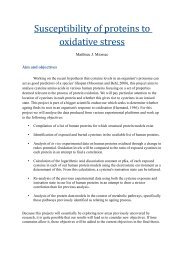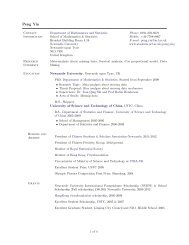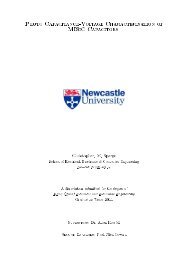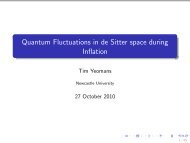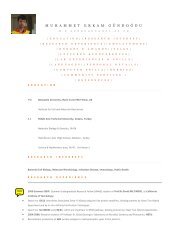Retinal Prosthesis Dissertation - Student Home Pages
Retinal Prosthesis Dissertation - Student Home Pages
Retinal Prosthesis Dissertation - Student Home Pages
You also want an ePaper? Increase the reach of your titles
YUMPU automatically turns print PDFs into web optimized ePapers that Google loves.
Typically AER is used as a multi sender, multi receiver asynchronous protocol<br />
whereas however in this epiretinal approach to a retinal prosthesis application its<br />
neuromorphic capability is as a timed synchronous protocol. In other words as there<br />
is only a single image to be transmitted; although each image is composed of<br />
multiple pixels, then this time multiplexed synchronous protocol will not have<br />
contention between AER packets. So despite the image signal eventually being<br />
multicast to many electrodes an asynchronous protocol enabling handshaking and<br />
avoiding contention is not necessary or warranted and will eliminate overheads<br />
associated with such extra processing.<br />
1.2 Conceptual overview<br />
To accommodate the initial test setup described in the abstract a frame rate of 25<br />
frames per second (fps) was chosen, this corresponds to the UK TV camera standard.<br />
The UK TV standard; as with the 25p video format, deals with persistence of vision<br />
where an after image of a stimulus remains long enough for the phi phenomenon (an<br />
optical illusion) to occur i.e. the perception of movement. At 1fps to transmit each<br />
pixels worth of information would take 1s divided by the pixel size of the image. So<br />
for a four by four image i.e. sixteen pixels, pixel time would equal 1/16 i.e. 0.0625s<br />
meaning 16Hz for the frequency of AER packets i.e. synonymous with pixel<br />
frequency. Each AER packet contains the pixel address and payload e.g. pulse count,<br />
corresponding to the colour information, during the AER transmission. At 25 fps the<br />
frequency of AER packets, for this example, would be 25*16=400Hz. The frequency<br />
of AER packets (f packet ) is the frame rate multiplied by the image size in pixels. There<br />
is a linear relationship between the frame rate for any particular image size and AER<br />
packet frequency that needs to be set e.g. 50*16=800Hz and for a 1024 pixel image<br />
@ 25fps, AER packet frequency would equal 25.6kHz.<br />
18 of 200




